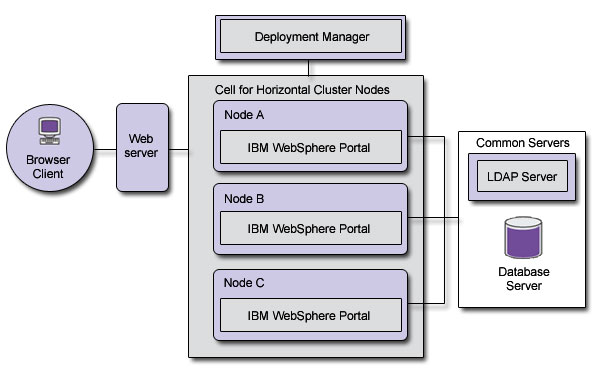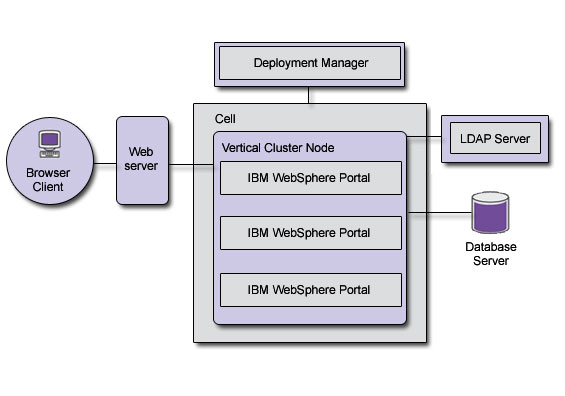Set up a cluster
Clusters enable you to scale your WebSphere Portal configuration. Clusters also enable enterprise applications to be highly available because requests are automatically routed to the running servers in the event of a failure. There are numerous cluster configuration, such as horizontal, vertical, multiple, and dynamic.
Prerequisites
- Technotes for installation and configuration issues
The following illustration depicts a horizontal cluster configuration where WebSphere Portal is installed on multiple servers. This configuration reduces single points of failure, but requires more hardware.

To conserve hardware, you can also set up a vertical cluster with multiple portal instances on a single node.

In response to customer requests, the instructions to setup WebSphere Portal has been improved to provide operating system specific instructions for setting up a production environment. Select your operating system to get started.
 After completing the installation remember to tune the servers in the portal environment in order to achieve better performance. The Base Portal Tuning scenarios in the WebSphere Portal and Lotus Web Content Management 6.1.x Performance Tuning Guide provides information about tuning the WAS, WebSphere Portal services, databases, directory servers and more. Base Portal Tuning scenarios are the foundation to most performance tuning. In a cluster environment, there are additional steps you should take to tune WAS, the Web server, and more.
After completing the installation remember to tune the servers in the portal environment in order to achieve better performance. The Base Portal Tuning scenarios in the WebSphere Portal and Lotus Web Content Management 6.1.x Performance Tuning Guide provides information about tuning the WAS, WebSphere Portal services, databases, directory servers and more. Base Portal Tuning scenarios are the foundation to most performance tuning. In a cluster environment, there are additional steps you should take to tune WAS, the Web server, and more.
First review and takes necessary steps provided in the Base Portal Tuning scenarios, then review and take additional necessary steps in the Tuning a Cluster Environment chapter of the tuning guide.
- Set up a cluster on AIX
You can install WebSphere Portal on a primary node and then add additional nodes . You can deploy a high availability production environment by creating clustered deployments of multiple servers running WebSphere Portal managed by IBM WAS Network Deployment.
- Set up a cluster on HP-UX
You can install WebSphere Portal on a primary node and then add additional nodes . You can deploy a high availability production environment by creating clustered deployments of multiple servers running WebSphere Portal managed by IBM WAS Network Deployment.
- Set up a cluster on i5/OS
You can install WebSphere Portal on a primary node and then add additional nodes . You can deploy a high availability production environment by creating clustered deployments of multiple servers running WebSphere Portal managed by IBM WAS Network Deployment.
- Set up a cluster on Linux
You can install WebSphere Portal on a primary node and then add additional nodes . You can deploy a high availability production environment by creating clustered deployments of multiple servers running WebSphere Portal managed by IBM WAS Network Deployment.
- Set up a cluster on Solaris
You can install WebSphere Portal on a primary node and then add additional nodes . You can deploy a high availability production environment by creating clustered deployments of multiple servers running WebSphere Portal managed by IBM WAS Network Deployment.
- Set up a cluster on Windows
You can install WebSphere Portal on a primary node and then add additional nodes . You can deploy a high availability production environment by creating clustered deployments of multiple servers running WebSphere Portal managed by IBM WAS Network Deployment.
Parent topic:
Installing WebSphere PortalRelated concepts
Cluster
Understand single-cell deployment scenarios
Web content authoring environments
Related tasks
Add a BPI-enabled portal server to a managed cell in a single-cell setup
Related information
Secondary node fails to start after being added to the cluster with javax.jcr.RepositoryException exception